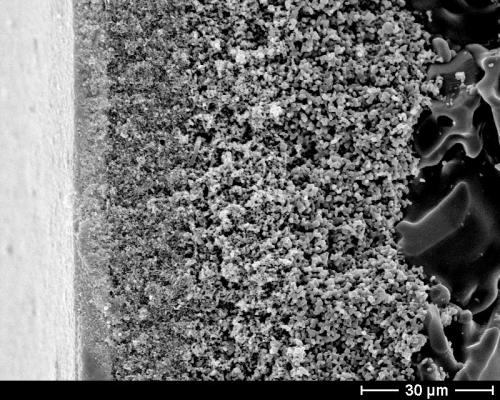
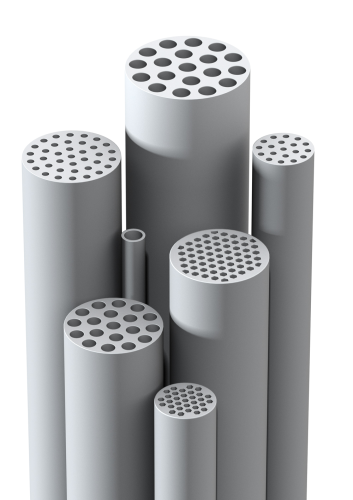
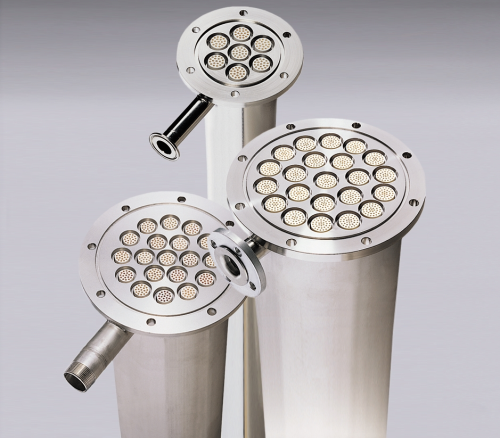
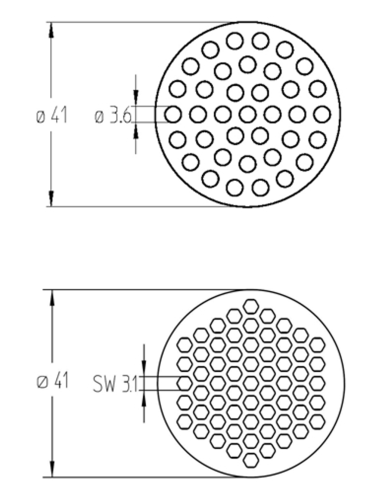
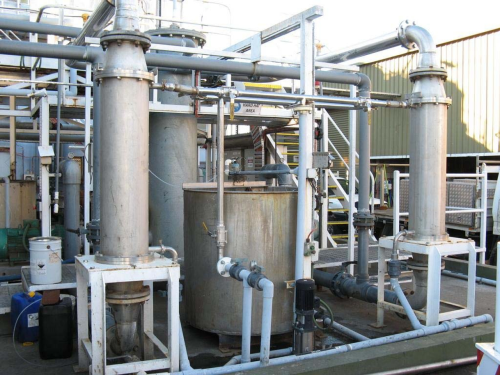
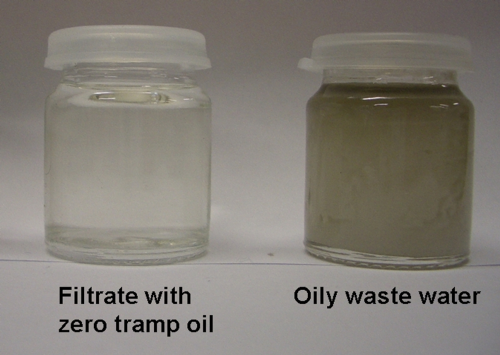
Schumasiv ceramic membrane filter elements made by Pall Corporation have been successfully used in different applications for many years. Examples are oil-water separation of compressor condensates, degreasing baths, coolant lubricants and washing waters, filtration of process waters, catalyst recovery in chemical processes, biomass separation in wastewaters and various applications for clarification of beverages. Schumasiv membranes are available as tubular mono and multi-channel filter elements. They have a support body made of pure α-alumina, the chemically stable phase of alumina. The membranes are made of alumina, zirconia or titania depending on the pore size. Due to a fine graded multi-layered structure having a coarse support coated with several layers of decreasing pore size, membranes with a wide range of pore sizes are manufactured covering the whole range of micro and ultra filtration from 2 to 0.005 μm. In Figure 1, the structure of a 0.05μm ultrafiltration membrane is shown as an example. Ceramic membranes have an excellent resistance against abrasion and chemically aggressive fluids. Furthermore, they have high mechanical strength, good thermal resistance and high separation efficiency. The mono and multi-channel Schumasiv filter elements are available with different diameters of the flow channels from 2.8 to 16 mm. This enables their use in a wide variety of applications having different solid concentrations. Schumasiv membrane filter elements have a length up to 1.5m. The outer diameters of the multi-channel filter elements are typically 25.4mm (19 channels with 3.3mm channel diameter), 41mm (19 channels with 6mm channel diameter or 37 channels with 3.6mm channel diameter) and 52mm (19 channels with 8mm channel diameter). Figure 2 shows some examples of the filter elements with different geometries. The ceramic membrane filter elements are installed in module housings (see Figure 3). Standard housings can have up to 27m2 of filtration area per housing. The filter elements are easily installed with O-ring seals. Due to their resistance in the pH range from 1 to 14, ceramic membranes can be cleaned with aggressive chemicals, organic solvents, hot water or steam. Furthermore, ceramic membranes can be regenerated by back flushing with high pressures, and they have a long service life.
High packing density
In order to reduce size and cost of a filter system, new ceramic membrane filter elements with a high packing density of filtration area have been developed.
By increasing the packing density of the filtration area, a larger membrane surface per filter element could be achieved without changing the outer diameter and length of the existing filter elements. This enables an increase in filtration rate in existing membrane systems by replacing the existing ceramic membrane filter elements. A reduction in the number of filter elements and correspondingly the size and costs of the filter system for new installations will also be demonstrated in the case studies.
The membrane surface per filter element has been increased by a more dense packing of the flow channels. A hexagonal geometry of the cross-section of the flow channels has been selected to enable a very dense packing like a honeycomb. The hexagonal outline of the flow channels allows for ceramic membrane filter elements with a very high packing density of the membrane surface. Compared to the usual round geometry of the flow channels, an increase of filtration area per filter element by 50 percent has been achieved. For example, the filtration area of a multi-channel membrane filter element with an outer diameter of 41mm and a length of 1.2m has been increased from 0.5m2 to 0.75m2. The number of flow channels has been increased in this case from 37 (round channels with a diameter of 3.6 mm) to 61 channels (hexagonal channels with a hydraulic diameter of 3.1 mm) per element (Figure 4). The improvement of a more dense packing of the filtration surface results in a higher permeate flow per filter element.
Oil-water separation
Schumasiv ceramic membrane filter elements are a good choice for oil-water separation applications because of their excellent mechanical, thermal and chemical stability, as well as their high filtration efficiency, high permeate flow and long-term durability. In recent years these filter elements have exhibited excellent performance in many oil-water separation applications. The new Schumasiv membrane filter elements with the hexagonal flow channels continue to provide all the benefits of the previous Schumasiv membrane filter elements. At the same time, they enable increased permeate flux per element and a cost reduction of the membrane filter system.
The following two case studies highlight and demonstrate the successful and advantageous use of the new filter elements in oily wastewater treatment applications. One case study is the successful increase of the filtration rate by replacing previous Schumasiv membrane filter elements with round channels with hexagonal channels and increased packing density of the filtration surface. The second case study reports on a new installation where the size of the filter system has been reduced taking full advantage of the higher surface area of the Schumasiv hexagonal channel filter elements.
Case study — Replacement
In the year 2000, a recycling company built a filtration plant (see Figure 5) for the treatment of mixed waste waters, oily waters and emulsions from different industrial sources. The plant originally used 1.2m long Schumasiv ceramic membrane filter elements with an outer diameter of 41mm and 37 round flow channels with a channel diameter of 3.6mm. Due to a large expansion of the local wastewater market, the customer needed to increase the throughput capacity of the recycling plant. The customer became aware of the new Schumasiv ceramic membrane filter elements with the dense packing of the membrane surface developed by Pall Corporation. Some trials were performed with the new membranes in the existing filter test rig in order to evaluate the increase in filtration rate that could be achieved with the higher packing density of the filtration area.
The newly designed Schumasiv filter elements offered the possibility of a simple upgrading of the existing filtration plant and the increase of the throughput capacity by replacing the existing ceramic membrane filter elements with the newly developed ones. The trials were successful and the customer decided to replace the existing ceramic membranes in the plant with 61 hexagonal flow channels (element length: 1.2m; outer diameter of the elements: 41mm).
With the replacement of the filter elements, the customer has achieved an increase of the filtration rate of the plant from an average of 2200 l/h to 3200 l/h. The 45 percent increase at constant high filtrate quality corresponds to a nearly complete utilisation of the increased surface area. The new filter elements have been in operation since 2008 without any problem.
The increase of the production capacity of the plant from 350,000 l to 510,000 l per week is an important success for the customer. This has been achieved at reasonably low costs and with a very short loss of production time during the exchange of the filter elements. Only the filter elements had to be replaced. All other parts of the plant, such as the existing housings, pumps, valves and piping could still be used and did not need to be replaced. The payback period of the cost was three months. The customer has expanded the plant capacity even further by installing an additional housing with hexagonal channel Schumasiv filter elements.
Case study — New installation
A chassis manufacturer collected oily waste coolants from a machining shop and shipped it by tanker twice a week. Onsite installation of a cross flow filtration system in order to reduce the waste volume offered significant cost savings. Calculations based on using a compact filter system with the new Schumasiv filter elements with the dense packing of the filtration surface showed an interesting return on investment time of less than one year. Thus, the customer decided to buy a Clarisep cross flow filter system from Pall with the new hexagonal channel Schumasiv elements. The filtrate quality is so good (see Figure 6) that the customer can discharge it to the foul sewer without any further treatment step. The oily concentrate is collected in containers and shipped by tanker only three times per year — a significant reduction compared to two times per week before the installation of the Pall Clarisep filter unit. The customer is happy with the Clarisep system with the new Schumasiv ceramic membrane filter elements and is now looking for similar applications at other locations.
Conclusions
The new Schumasiv ceramic membrane filter elements with high packing density of the filtration area enables an easy upgrading of existing filter systems by replacing the filter elements. This has been demonstrated by a case study where the filtration rate has been increased 45 percent by replacing the old filter elements with the new Schumasiv filter elements without any additional change of the filter system.
For new installations, the number of filter elements and correspondingly the size of the filter housings and costs of the filter system can be reduced by using the new Schumasiv filter elements with higher filtration surface.





